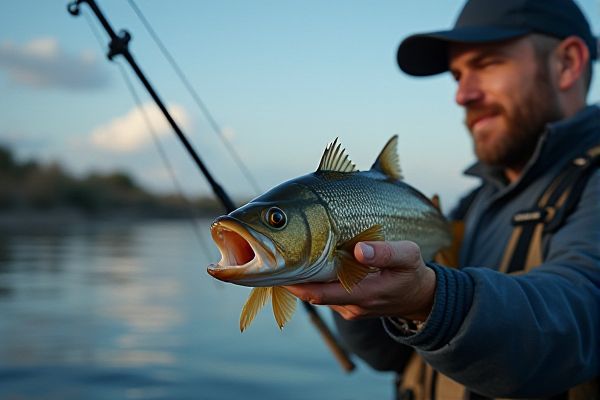
AI technology enhances fishing efficiency by analyzing patterns in fish behavior and environmental conditions. Machine learning algorithms process data from sensors and satellites to identify optimal fishing spots and times. Predictive analytics assist fishermen in assessing fish stocks and migrations based on historical data. Integrating AI tools into fishing practices promotes sustainable methods and reduces bycatch, benefiting both the industry and marine ecosystems.
AI usage in fishing optimization
Automatic Fish Detection
AI can enhance fishing optimization by employing automatic fish detection technologies. Such systems analyze underwater data to identify the presence of fish species, improving catch efficiency for commercial fisheries. For example, a fishing vessel using AI-driven sonar can potentially increase its yield by targeting specific locations with higher fish density. This approach not only supports sustainable fishing practices but also reduces waste, creating a more advantageous outcome for both the industry and marine ecosystems.
Fishing Pattern Analysis
AI can analyze historical fishing data to identify optimal fishing patterns, improving catch efficiency. By leveraging machine learning algorithms, fishermen can predict fish movement based on environmental factors such as temperature and salinity. Models trained on data from institutions like the Marine Institute can significantly enhance understanding of fish behavior. The possibility of reducing wasted effort and increasing sustainable practices presents substantial advantages for the fishing industry.
Bycatch Reduction Algorithms
AI-driven fishing optimization can significantly reduce bycatch through advanced algorithms that analyze real-time data. For example, fisheries can employ machine learning techniques to predict species movements and improve target species catch rates. The incorporation of these algorithms may lead to more sustainable fishing practices, ultimately benefiting marine ecosystems. Implementing such technologies can also enhance compliance with regulations for institutions like the Food and Agriculture Organization (FAO).
Real-time Maritime Monitoring
AI can enhance fishing optimization by analyzing real-time data on fish migration patterns. By employing technologies like satellite imaging, organizations such as NOAA can monitor marine environments more effectively. This data-driven approach allows fishers to target species with higher abundance, potentially increasing catch efficiency. Real-time maritime monitoring can also contribute to sustainable practices, ensuring that fishing efforts align with conservation efforts.
Ecosystem Impact Assessment
AI can enhance fishing optimization by analyzing data on fish populations and environmental conditions, leading to more sustainable practices. For instance, institutions like the National Oceanic and Atmospheric Administration (NOAA) are employing AI to forecast fish migrations and adjust fishing quotas accordingly. The integration of AI in Ecosystem Impact Assessments allows for better monitoring of ecological health and biodiversity. This technological approach may result in improved yields and preservation of marine resources over time.
Acoustic Data Analysis
AI can enhance fishing optimization by analyzing acoustic data to identify fish populations and behaviors. This technology, employed by institutions like NOAA, allows for more efficient resource management in fisheries. By processing large datasets, AI can provide insights that lead to better catch predictions. The potential for increasing yields while minimizing environmental impact makes this approach advantageous for sustainable fishing practices.
Smart Net Deployment
AI can enhance fishing optimization by analyzing real-time data to determine the most effective areas for catch. Smart net deployment systems utilize algorithms to automatically deploy nets based on environmental conditions and fish movement patterns. This technology increases the chances of a successful haul while minimizing bycatch. For example, organizations like Conservation International are exploring AI solutions to improve sustainable fishing practices.
Weather Forecasting Integration
AI can enhance fishing optimization by analyzing data patterns and predicting fish behavior based on environmental factors. Weather forecasting integration plays a crucial role in this process, as it helps determine the best times for fishing by evaluating conditions like temperature and precipitation. Utilizing machine learning algorithms can increase catch efficiency and reduce operational costs for fisheries. These advancements may also provide sustainable practices, benefiting both fishermen and marine ecosystems.
Resource Allocation Optimization
AI in fishing optimization can enhance catch prediction by analyzing historical data and environmental conditions, increasing the likelihood of a successful catch. Resource allocation optimization through AI allows fisheries to efficiently distribute their assets, ensuring that resources are utilized effectively. For instance, using AI algorithms for fleet management can reduce operational costs and improve overall productivity. The integration of AI tools can potentially lead to more sustainable fishing practices, balancing economic gains with environmental responsibility.
Sustainability Tracking
AI can enhance fishing optimization by analyzing data on fish populations and environmental conditions, allowing for more efficient catch methods. Implementing AI-driven sustainability tracking can provide insights into the health of marine ecosystems, ensuring that fishing practices remain eco-friendly. Companies like OceanMind are already using AI to monitor trawling activities, helping to reduce overfishing. This technology could lead to better regulatory compliance and promote long-term resource recovery.
 techknowy.com
techknowy.com